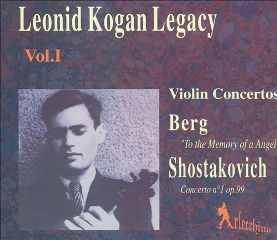Berg, Shostakovich - Violin Concertos
Berg, Shostakovich - Violin Concertos

Berg - Violin Concerto - Dem Andenken eines Engels 1. I. Andante – Allegretto 2. II. Allegro – Adagio Shostakovich - Violin Concerto No. 1 in A minor, Op. 77 (published as Op. 99) 3. I. Nocturne. Moderato 4. II. Scherzo. Allegro 5. III. Passagalia. Andante 6. IV. Burlesque. Allegro con brio Leonid Kogan – violin USSR Radio & TV Symphony Orchestra Gennady Rozhdestvensky – conductor Evgeny Svetlanov – conductor
One of the twentieth century's greatest violinists, Leonid Kogan was less widely known than his somewhat older contemporary David Oistrakh, but no less a first-tier artist. More concentrated in tonal focus and with a quicker vibrato than Oistrakh and others of the Russian school, Kogan was avowedly a man of his time. His espousal of the four-octave scale for exercises assured the infallibility of his technique by strengthening his fingering hand in the upper positions. Although he died at age 58, he had amassed a discography that remains as a commanding legacy. Although his were not especially musical parents, Kogan conceived a fascination for the violin by age three. At six, he began lessons with Philip Yampolsky, a pupil of Leopold Auer. When Kogan's family moved to Moscow when he was ten, he began studies with Abram Yampolsky (no relation to Philip, but another Auer disciple). Kogan progressed through the Central School of Music, then the Moscow Conservatory, where he trained from 1943 to 1948. Postgraduate studies at the conservatory occupied him from 1948 until 1951. At age 12, Kogan was heard by violinist Jacques Thibaud, who predicted a great career for him. Although his parents resisted exploiting their son as a prodigy, Kogan made his debut at 17 and performed in many Soviet venues while still a student. Wider recognition came when Kogan shared first prize at the 1947 Prague World Youth Festival. In 1951, he won first prize at the Queen Elisabeth Competition in Brussels. Oistrakh, who was a member of the jury (along with Thibaud), thereafter came to regard Kogan as a colleague, while Kogan closely observed his elder associate during the latter's evening classes for other students. After teaching at the Moscow Conservatory and playing a busy schedule of concerts in the Soviet Union over the next few years, Kogan made his first appearances in Paris and London in 1955, following those with a tour of South America in 1956 and another of the United States in 1957. Less gregarious than Oistrakh, Kogan was not as aggressively promoted abroad by the Soviet government. After being named People's Artist in 1964, Kogan received the Lenin Prize in 1965. --- Erik Eriksson, Rovi
download: uploaded anonfiles mega 4shared divshare mixturecloud yandex mediafire ziddu
Last Updated (Saturday, 24 August 2013 11:36)








